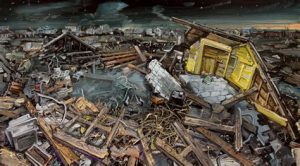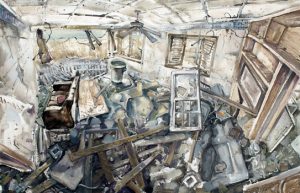Coping Mechanisms for the Negative Emotional Effects of Natural Disasters
Coping Mechanisms for the Negative Emotional Effects of Natural Disasters
To help deal with the negative effects like PTSD and similar problems caused from climate change or other natural disasters, studies have started to be been done to try find the most effective coping mechanisms.
Many studies are focused on children due to the fact that research has shown they are affected more by natural disasters because their brains are still developing. In the article “Katrina Inspired Disaster Screenings and Services”, research is done to see the if having programs during the school day in areas effected by disasters is helpful for the students who are dealing with emotions caused by the residual effects from disaster. The experiment was conducted years after Hurricane Katrina the students who received services demonstrated a greater significant adjusted result compared to the students who did not receive services. The Results revealed a statistically significant decrease on PTSD scores, approximately 40% showed reliable improvement (Hansel, Katrina Inspired Disaster Screenings and Services).
Art therapy is one of the most productive forms of coping with trauma from disasters and is shown to have many positive outcomes of success in helping children along with adults deal with mental illness caused from experiences related to natural disasters. This is because when dealing with trauma sensory, physical, somatic and body-oriented treatments are the most helpful. Everyone has a different way of perceiving the environment, or an umwelt, because of this using art to talk about how they feel is useful especially when people have hard time expressing what they are feeling with words. “Art therapists have observed that following a natural disaster people often can- not put their experience into words. Involvement in the creative arts affords expression of the nonverbal aspects of the traumatic imprint in order to safely access the memory”(Mohr, Posttraumatic Growth in Youth Survivors of a Disaster).
Art-based research that allows the participants to look into their lived experiences, offers a “process of insight and growth that became embodied within the natural structures of time and space” ( Mohr, Posttraumatic Growth in Youth Survivors of a Disaster). This potential is achieved through the creation of safe spaces that allow for imaginative communication and thought. Along with a way of reframing their trauma which allows for further growth.
Many people who have not directly been affected by natural disasters and climate change still have been affected emotionally. More people than any years prior are starting to surer from eco anxiety and fear for what our futures hold. Because of this many people look for outlets to express how they are feeling and many turn to art and music. This is because not only does it give them a way to deal with it but also allows them to communicate ideas and problems around climate change in other ways then just looking at graphs. The arts can also bridge the divide between logic and emotions which can be helpful when dealing with emotional problems due to natural disasters.
For example, students at the University of Minnesota wrote a string quartet that shows the rising temperatures of the Northern Hemisphere since the 1880s. The song shows that the earth is warming along with where and by how much by using different instruments to symbolize different speed of warming and location.(Hansman)
Another example is Amer Kobaslija, who depicts the aftermath of natural disasters. One of his series is done after Hurricane Sandy on Staten Island, New York. Kobaslija often paints senses of destruction; he sees aesthetic beauty in the midst of horrific tragedy. Kobaslija makes connections between natural disaster and human made disasters along with how devastations of war have similarities to the way a storm can wipe out a city. He explained, “I could not help but draw parallels between the human-caused destruction in the land of my ancestors and the ongoing catastrophe, with its confluence of natural disaster and human falling.”(Gomez) Kobaslija relates his memories of the war in Bosnia during his childhood to the destruction of the hurricane and sees the aesthetic beauty that can be seen in the midst of horrific tragedy.
 Kissan Ave, Oakwood beach,2013. oil on paper, 23″x 31″
Kissan Ave, Oakwood beach,2013. oil on paper, 23″x 31″
Kobaslija recounted in heavy, painterly strokes the traumatic events of the storm memorializing it into an aesthetically complicated, abstract, web that viewers are drawn to, yet also repulsed by. He saw the aftermath of the storm as a perplexing area, yet beautiful in the devastation. He depicts a landscape that emphasizes the materiality of the chaos and destruction of ruined personal belongings and housing along with showing the sheer magnitude of the storm and how densely populated cities display the scale of destruction wreaked by natural disasters. (Gomez) His works show what the world is and will continue to be if something isn’t done about our planet’s climate problem. These paintings give viewers realistic representations of what could easily happen to them if things do not change, and allows for the topic of climate change to be discussed outside of the scientific realm.
 House Near the End of Kissam Avenue, November 6 (Staten Island), 2012. oil on paper, 20″ x 30″
House Near the End of Kissam Avenue, November 6 (Staten Island), 2012. oil on paper, 20″ x 30″